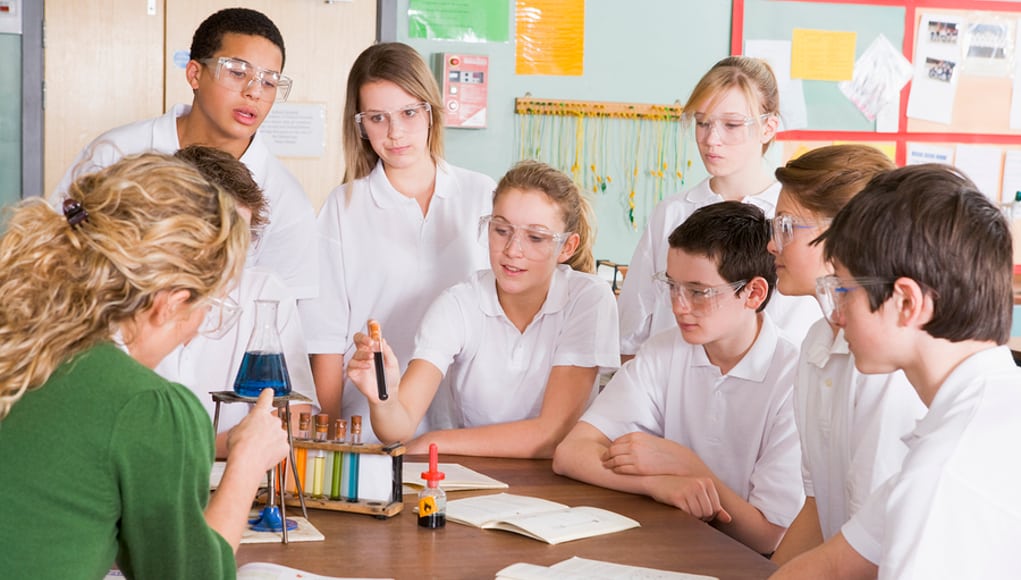Science Assessments Under NGSS: What Can We Expect?

By Ron Drabkin and Emily Liebtag
Historically, science assessments were designed to measure if students had mastered a large amount of content via memorization of science facts. Therefore, many science assessments were primarily multiple choice tests.
There often was so much focus on the amount of content to be tested, that assessment writers spent their time trying to figure out how to test so much detail in the limited time available. Students ended up needing to speed through the multiple choice tests in order to finish. A good example of the old variety of assessment is the AP science tests; which until recently covered so much ground that many teachers complained they had no time to dive deep into any particular subject.
Typical multiple choice tests are not usually a good assessment of deeper knowledge or a student’s ability to apply what they have learned, which in many ways should be the goal of science – to test, explore, hypothesize and experiment. The introduction of the Next Generation Science Standards (NGSS) has been a catalyst and for the development of assessments that are more aligned to what we actually want young scientists to be able to do and perform.
“Science assessments have been orphaned for over a decade, ignored first by NCLB, not included in Common Core, and with the exception of the ACT – excluded from college entrance exams,” stated Tia Sukin, Director of Research at Pacific Metrics, an ACT Assessment Technologies company.
What’s Different with the Next Generation Science Standards?
The NGSS, now being adopted more broadly, brings promise for more robust and meaningful assessments in science. The NGSS were developed to focus more on science and engineering practices in order to encourage authentic application of skills and knowledge. There is not only richer and more rigorous content knowledge for students to learn, but also an emphasis on students understanding the scientific process.
Previously, students may have experienced both (rich science content and ample time to understand and demonstrate mastery of scientific processes), but only were mostly assessed just on the content. One the largest differences between NGSS and older science standards is the additional NGSS focus on process; such as capturing a storyline, explaining a phenomenon, or developing a hypothesis.
Science standards previous to the development of NGSS encouraged the generation of assessments that relied on the recall of information found in textbooks and did not engage students in the associated phenomena or inspire self-investigation of concepts. With the adoption and implementation of the NGSS and aligned assessments, students are much more likely to engage in BOTH.
“Adoption of the NGSS represents a new challenge and opportunity for standards-based assessment. Existing assessments will not be adequate to thoroughly and appropriately address the NGSS performance expectations,” continues Sukin.
Focus on Application. Given the NGSS Science and Engineering Practices, which encourage students going deeper in their understanding and using what they have learned, assessments need to have opportunities for application of knowledge and skills. This will require more performance assessments and open-ended critical thinking problems.
Use of Simulations and Online Models/Tools. As stated above, any science standard can be split into two types, those focused on knowledge of content, and those focused on process. Multiple choice questions excel at assessing knowledge of content, but are typically less practical for assessing the application of processes.
An exciting new trend for schools that have online access for their students is the use of science simulations and tasks, such as Concord Consortium, PowerMyLearning, PhET and those that can be found on OpenED (such as those via PrepMagic). Historically, science teachers have done things like introduce pea plants into the classroom to promote deep learning of Mendel’s hypotheses. There will always be a place for that kind of exercise, but using a computer-based simulation such as this one is an excellent and quick compliment.
Assessment providers recognize the ability to incorporate interactivity, so we can expect to see actual simulations built into NGSS aligned assessments to help accurately assess if students have learned the process based standards.
More Relevant Constructs. Schools like Del Lago Academy – Campus of Applied Science that implement and assess NGSS know that the days of made up scenarios and tasks are long gone. While this may have always been true, it seems like more than ever students want to make an impact and do real-world work.
Due to the fact that the NGSS are focused on next-gen science ideas, innovations and technologies, students often are much more engaged as they are learning about current topics and issues. At Del Lago, educators use the NGSS as the baseline for projects, internships, partnerships and instruction.
Integration of Literacy. Resources aligned to NGSS standards often include related literacy standards. As an example, HS-PS1-1 (a high school NGSS physics standard) is a high school chemistry standard that says students should master using the periodic table as a model to predict properties of atoms.
This standard also contains a Common Core Literacy standard that requires students to translate between charts and words and words and charts. Therefore, to demonstrate mastery of the writing or literacy parts of the standards, assessments will need to have written responses.
Beyond these differences, the NGSS provide high expectations for students to strive toward. We know that for students to be successful in their futures, more of the same and rote learning will not suffice. Certainly, we hope all assessment from formative to summative will ask students to dive deeper and apply what they learn. As a result, we also hope there will be an overall improvement in college and career readiness and overall scientific literacy of students.
For more, see:
- Rethinking High School: Badging, Competency-Based and Real-World Work
- 9 Simple Steps that Inspire Inquiry-Based Learning in Science
- Smart Review | Science Comic Series is Fun Reading
Ron Drabkin is VP of Marketing for OpenEd. Follow him on Twitter: @DrabkinRon
Stay in-the-know with all things EdTech and innovations in learning by signing up to receive the weekly Smart Update.







0 Comments
Leave a Comment
Your email address will not be published. All fields are required.